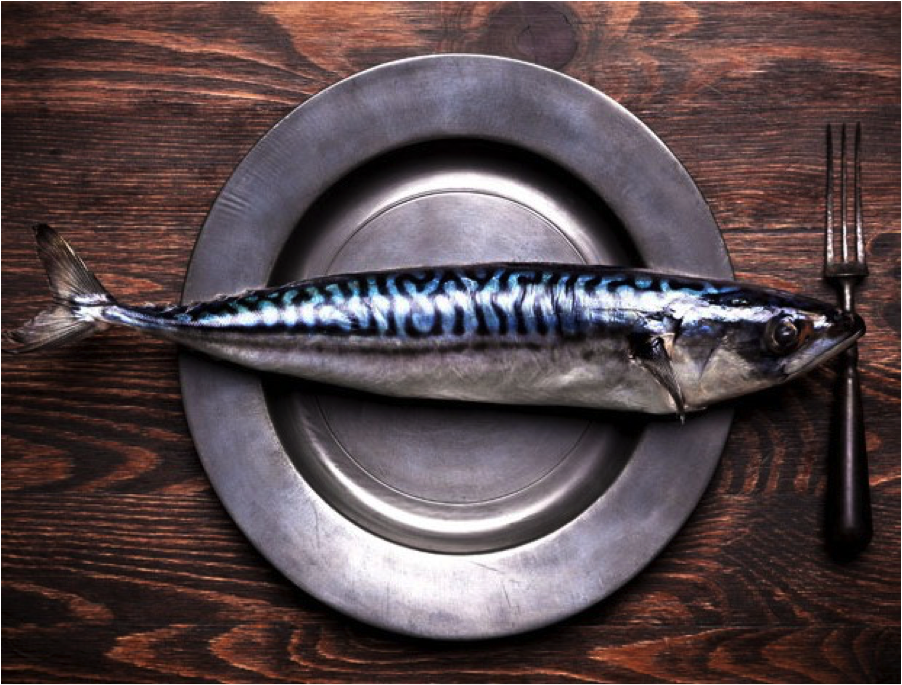
Let’s face it, fish as a dietary inclusion seems to enjoy an almost (excuse the terminology) “sacred cow” status that no one bothers to question. It seems to be the darling of every health enthusiast out there. Even a number of self-proclaimed vegetarians/vegans will curiously mention that they also (paradoxically) include fish as part of their diets, while adamantly eschewing all (other) forms of meat.
Mind you, I could go on and on (and have been known to do so) about all the potential risks associated with seafood consumption nowadays (another tome for another time, perhaps), but IS fish/seafood really and truly key, much less somehow indispensable to our health? Is it REALLY the “ultimate” brain food, as everyone seems to assume? And what role did fish/seafood actually play in our prehistoric ancestral diets?
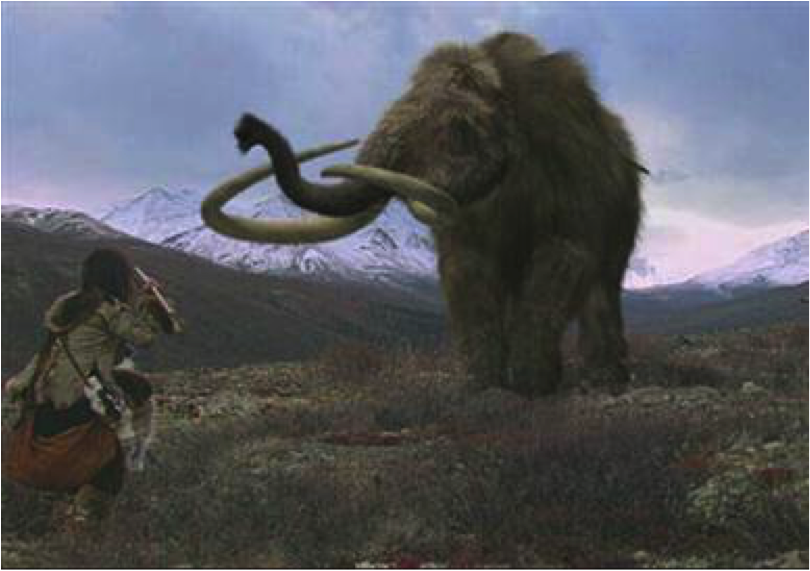
There was an article published just this month in Science Daily titled, “On the early human’s menu: Mammoth and plenty of raw vegetables.” They followed this headline by saying, “Early modern humans consumed more plants than Neanderthals but ate very little fish.” (bold emphasis added)
Yep—fish didn’t build our brains…I’m just saying.
But dietary animal fat DID.
Basically, in the new study being discussed in the article, researchers had looked at the diets of the earliest anatomically modern humans and were able to determine through some advanced isotopic analysis that “just like the Neanderthals, our ancestors had mainly mammoth and plants on their plates—[but] the researchers were unable to document fish as part of their diet.”[1] (bold emphasis added)
So we often forget that throughout our entire Pleistocene evolutionary history—from about 2.6 million years ago to roughly 10,000 years ago— we coexisted on this planet with at least 120 species of massive megafauna herbivores (like woolly mammoths and a whole bunch of other massive species) that simply vanished about 10,000 years ago about the time the Younger Dryas came to a rather abrupt and cataclysmic end.
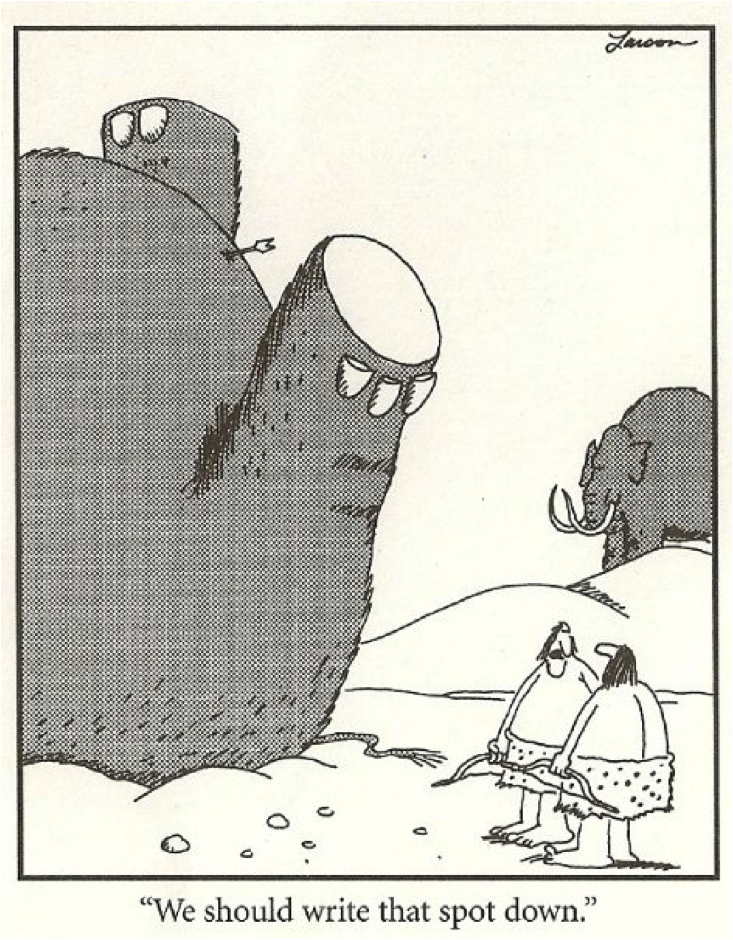
But until that time (and frankly, since), for prehistoric and even Neolithic human hunters the bigger our prey animals were, the fattier and sassier they were, the more avidly we hunted them. And by the way, it is estimated that the body fat of a woolly mammoth was no less than 50% (extrapolating from the known body fat % of elephants) –and likely more. So we weren’t hunting for just meat… We were hunting for FAT!
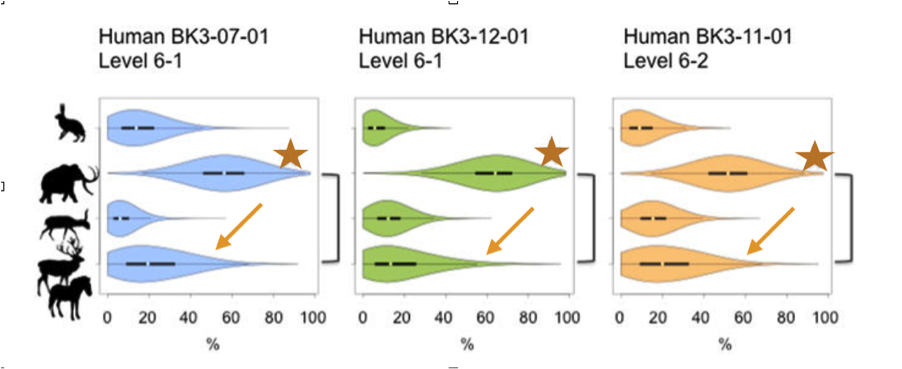
Here is an illustration from the actual study, which was published in the journal, Scientific Reports, (again) just this month (August, 2017).[2] You can see how mammoth meat actually dominated the diets of our oldest anatomically modern ancestors, while the second most popular item on the menu in this study was also the second fattiest type of animal they had available, namely red deer and horses. After that they probably ate more hare than saiga antelope mainly because rabbits were undoubtedly much more plentiful, and also easier to catch by trap or snare. Rabbits and antelope are both, of course, inherently much leaner animals.
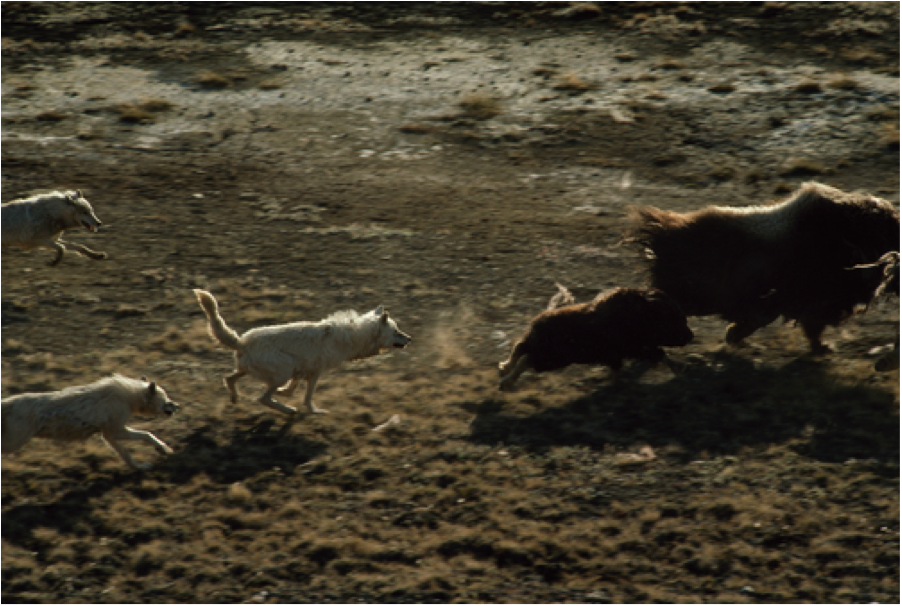
As many reading this may already know, I spent time studying and living among wolves in the High Arctic and was able to spend time over the course of an entire High Arctic summer closely observing their daily behaviors, including hunting.
I think it’s especially interesting to point out that wolves (and other hunting carnivores), unlike us, habitually go for typically the youngest or oldest and most weak or vulnerable prey when they hunt. It’s not that they don’t like eating fully healthy, fat and sassy animals. It is this way simply because these vulnerable animals are the easiest ones for them to catch. Wolves are incredibly cunning, but let’s face it, they lack opposable thumbs and sophisticated technology that might allow them to be more selective.
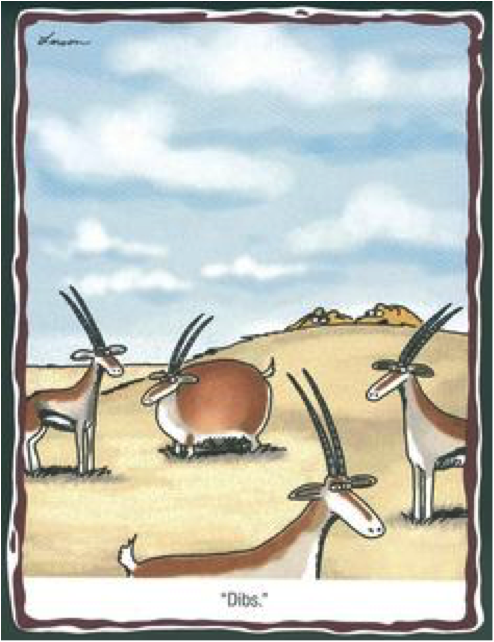
But we humans developed the technological means to hunt in a way more sophisticated manner, allowing us to be more selective of larger and healthier —and fattier prey– even when that selection may have been less convenient or more difficult and certainly far more dangerous for us to catch. This says a lot about the importance of our early preferences for fat, and it is this early preference that shaped us in ways we have yet to fully appreciate.
According to all of the available paleoanthropological data, our human Paleolithic ancestors consistently chose to hunt fully mature animals, bulls and females in their prime, where their fat levels would have been the highest– even (again) as these animals would have been the hardest and riskiest for us to hunt. It tells you something about the rather extreme value we placed upon dietary fat from large animals. It was every bit worth the risk to us to go after it!
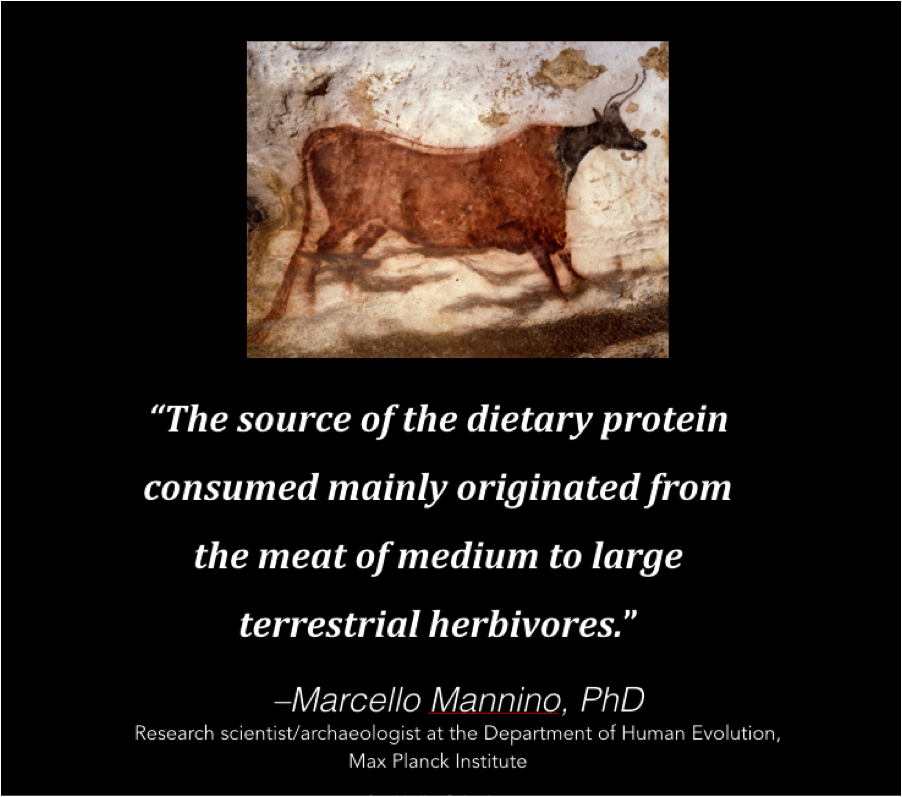
Even in the more recent prehistoric Mediterranean region, where one might imagine that easily gotten seafood would have absolutely dominated the human diet…. according to Dr. Marcello Mannino, research scientist and archaeologist at the Department of human evolution at the Max Planck Institute, “The source of the dietary protein consumed [in the late prehistoric mediterranean region] mainly originated from the meat of medium to large terrestrial herbivores.” (i.e., giant aurochs, red deer and wild boar). NOT fish. He is referring to the late Pleistocene, btw, following the major post-glacial changes (and the widespread extinction of woolly mammoths and other megafauna that were taking place at that time). In other words, even where fish was readily available as a food source we still tended to prefer going after fattier red meat.[3]
In the same PLoS One study the authors also stated that, “Carbon and nitrogen isotope analyses show that the Upper Paleolithic and Mesolithic hunter-gatherers of Favignana consumed almost exclusively protein from terrestrial game and that there was only a slight increase in marine food consumption from the late Pleistocene to the early Holocene.” (bold emphasis added)
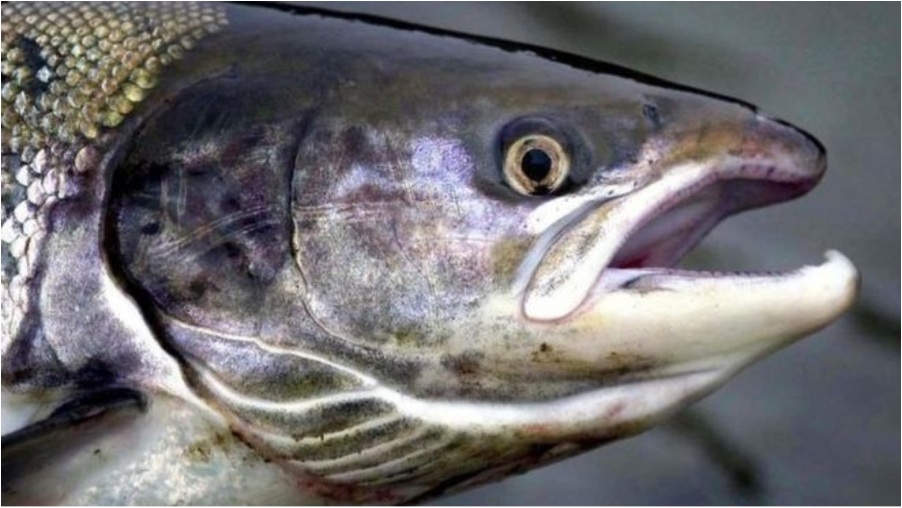
SO despite the fact that everyone likes to refer to fish as “brain food” we simply didn’t get all the way from there to here, brain-wise, by eating a bunch of salmon or sardines.
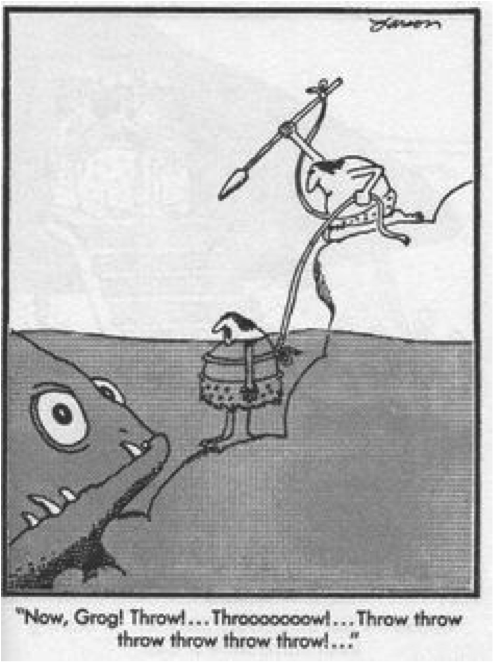
What does red meat uniquely have for your brain that fish doesn’t?
In addition to EPA and DHA (present in both red meat and fish), fully pastured red meat contains other nutrients essential (and/or highly beneficial) to a healthy functioning brain:
- Heme iron – needed for healthy cognitive function and brain oxygenation, learning and memory[4])
- Creatine – “Creatine plays a pivotal role in brain energy homeostasis, being a temporal and spatial buffer for cytosolic and mitochondrial pools of the cellular energy currency, adenosine triphosphate and its regulator, adenosine diphosphate.”[5])
- L-Carnosine – which enhances and even restores mitochondrial function…and your brain has a LOT of mitochondria! It can also even help prevent the creation and accumulation of beta amyloid![6])
- Arachidonic acid (AA) – Yes, I know….eeeeevil arachidonic acid. It is typically denounced as an inflammatory animal source omega-6 fatty acid, only what they don’t tell you that 11% of the fatty aciids in your brain are supposed to be AA and—together with DHA are the 20- and 22-carbon fatty acids that uniquely characterize human cognition… Also overlooked is the fact that your body’s own endocannabinoids—both Anandamide and 2-AG–are actually derived from AA, and these work together with the key homeostatic molecular signalling system of the human body—our endocannabinoid system that literally regulates your brain, nervous system, all your neurotransmitters and hormones, your immune system…and pretty much everything else![7])
- CoQ10 – found most readily in heart, liver and brain tissue of animal source foods, it is also pretty high in red meat, in general. CoQ10 energizes mitochondria and exerts neuroprotective effects[8] [9])
- CLA – One of the powerful attributes of CLA from grass-fed meat—not synthetic supplements– is its ability to suppress inflammatory prostaglandins such as PGE2. Blocking this substance reduces inflammation in the joints, muscles, bones, organs and brain. It has also shown promise in treating brain gliomas.[10])
Plus quality (i.e., fully pastured) red meat additionally supplies ample B vitamins, including riboflavin, niacin, pantothenic acid, vitamin B6, and (of course) B12, brain-nourishing cholesterol, choline, vitamin D3, A (retinol) and K2, and Taurine (most of which can certainly also be found in fish).
But I don’t recall seeing many paintings of fish on the cave walls of Lascaux, Chauveux or Altamira either… I’m just saying. The Aborigines in the Kimberly area of Northern Australia depicted a few chubby-looking fish in their rock art, and there was one very fat fish painted on the wall of a cave known as ‘Cueva del Gato’ in Spain; but let’s just say our ancestors didn’t waste much cave paint on them. What they DID paint to prolific extremes were disproportionally fat-looking mega-herbivores they habitually sought to hunt.
Unless you are eating fish from either very deep or very cold northern waters, the available fat content in most fish is rather modest, at best. In fact, that seems to be the point behind promoting fish as a health food oftentimes: the fact that it is mainly a source of lean protein and relatively low in fat (…..eeeeevil fat!)
And farmed fish (increasingly prevalent in the marketplace…as is feedlot meat) frequently contain highly questionable substances and dubious (far less healthy) fatty acid profiles.
To our early evolving human physiological makeup FAT—more than any other single nutrient— literally meant survival. And when it comes to what your body prioritizes, survival trumps everything else. And guess what else? We are 99.99% identical in terms of our genetic expression to these same early evolving human ancestors, even if we happen to be living in a climate controlled environment and are lounging on the living room couch, snacking on cheese doodles while watching some reality TV show, comfortably oblivious to the raging cold and winds of February in Minnesota just outside the living room window.
Dietary and body fat certainly provided our ancestors with highly efficient extra calories when they needed them— but fat is NOT just about calories! Our need (and especially our brain’s need) for fat did not simply go away because the Ice Age did. It also supplies us with a portable superfood pantry of critical fat-soluble nutrients and fatty acids that we absolutely require and that play an unimaginable range of roles in virtually every aspect of our health, brain and nervous system structure and function, cellular structure, mineral absorption/utilization, organ protection, endocannabinoid, endocrine and immune function!
NUTRIENT DENSITY would have always been absolutely paramount to us as an evolving species or primitive hunter and would have set the criteria for our most highly coveted sources of nutrition. There are a plethora of critical fat-soluble nutrients we absolutely require in significant quantity for optimal health.—According to Weston A. Price our ancestors likely got 10 times or more the amounts of several key fat-soluble nutrients than any of us do today— many of which are simply not available through plant source foods in the way that we need the most or can optimally use them. And these nutrients and essential fatty acids allowed for the development of many strikingly unique human characteristics, our brain being not the least of them. In fact, among all the healthiest cultures that Weston A. Price studied, regardless of whatever other diverse foods they may have had available to them, there were two dietary characteristics they all had in common: 1) they all consumed as many animal source foods as they had available to them, and 2) in every single culture, the most venerated and sought after dietary foods were consistently the ones highest in both fat, and fat-soluble nutrients.
Our heavy consumption of animal fats would have provided us with a much bigger and wider variety of fats and fat-soluble nutrients than otherwise available through our primate cousins’ limited diet. Their very limited consumption of meat and capacity for gut-based synthesis of short-chain saturated fats through bacterial fermentation would not have supplied them with meaningful quantities of those fatty acids essential for human cognition—AA and DHA.
Although DHA is certainly found in seafood most abundantly in cold water fish, it is also decidedly abundant in the fat of wild game and fully pasture-fed-and-finished meats. Our shift to a primarily hunting-based economy was already in full swing at 2 million years ago. Both our prehistoric and Neolithic ancestors were perpetually in pursuit of large, fat-and-sassy herbivores ever since (which always was their preference, when they could get them). And it is this—not fishing–that unleashed that unprecedented rate of rapid encephalization (brain development) in our species, which ultimately opened the floodgates to our almost unlimited human potential.
I am not totally trashing seafood here, in principle. Quality, fresh fish/seafood from uncontaminated waters (though, good luck with finding that nowadays) makes for a perfectly fine and healthy food. Cold water varieties (like salmon—especially king salmon– and herring) have decent enough DHA levels, with smaller fish like sardines also having typically decent amounts. Tuna and mackerel also have it—but are so potentially contaminated that no one should be eating them. I personally don’t consume any fish from the Pacific or Atlantic Ocean anymore, much less the Gulf of Mexico. In fact, the only salmon I really eat anymore comes from New Zealand and goes by the name, “Ōra King”. It’s Uber high in EPA and DHA (and probably the most delicious salmon I’ve ever eaten). I also order cold water Canadian walleye and lake trout from www.walleyedirect.com. It’s excellent.
Most seafood is also is a fairly viable source of just about every trace mineral that can play a role in human health (including, unfortunately, neurotoxic mercury, cadmium, and lead and chemical toxins like dioxin, PCBs, PCPs, radionuclides and a whole range of other undesirable contaminants awash in especially our oceans, but also many lakes rivers and streams). So there’s a bit of a trade-off there.
And yes, I will concede fish/seafood is technically good brain food—it’s just not the only source of brain food, or necessarily “the” best (or the least contaminated) source either… Plus it’s certainly not the source our ancestors preferentially used to rapidly grow/evolve their unusually big brains.
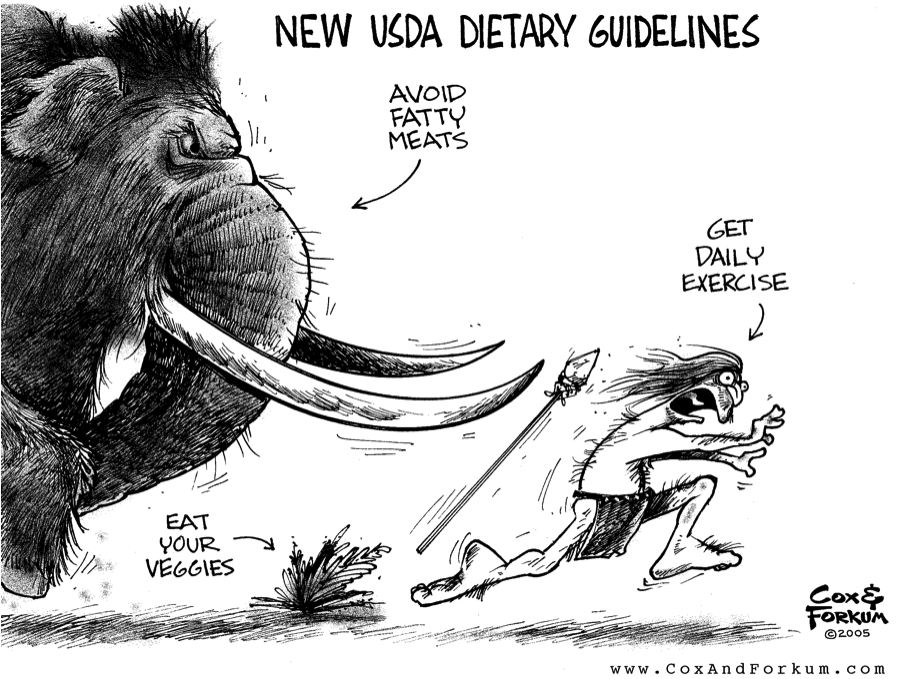
But it’s somehow a classic exercise in nutritional political correctness to put fish and seafood on a pedestal while inwardly and/or outwardly disparaging the imagined dangers of red meat (and, God forbid, animal fat/cholesterol). It’s all simply an artifact of draconian pseudo- “heart healthy” mythology. But to even suggest that fish/seafood might be anything less than the perfect food is almost akin to spitting in mother’s milk.
No offense intended here. I swear.
Most people like to call fish brain food.
I personally like to think of fatty 100% pasture-fed red meat (and not fish) as the ultimate (as well as our very first and best, tried-and-true) brain superfood!
So please pass the woolly mammoth.
~ Nora Gedgaudas, CNS, NTP, BCHN
REFERENCES
[1] “On the early humans menu: mammoth and plenty of raw vegetables.” Science Daily, August 4, 2017
[2] Dorothée G. Drucker, Yuichi I. Naito, Stéphane Péan, Sandrine Prat, Laurent Crépin, Yoshito Chikaraishi, Naohiko Ohkouchi, Simon Puaud, Martina Lázničková-Galetová, Marylène Patou-Mathis, Aleksandr Yanevich, Hervé Bocherens. “Isotopic analyses suggest mammoth and plant in the diet of the oldest anatomically modern humans from far southeast Europe.” Scientific Reports, 2017; 7 (1) DOI: 10.1038/s41598-017-07065-3
[3] Mannino MA, Catalano G, Talamo S, et al. “Origin and Diet of the Prehistoric Hunter-Gatherers on the Mediterranean Island of Favignana (Ègadi Islands, Sicily). PloS ONE. November 28, 2012. https://doi.org/10.1371/journal.pone.0049802
[4] Fretham SJB, Carlson ES, Georgieff MK. “The Role of Iron in Learning and Memory.” Adv Nutr March 2011 Adv Nutr vol. 2: 112-121, 2011.
[5] Rae C, Digney AL, McEwan SR, Bates TC. “Oral creatine monohydrate supplementation improves brain performance: a double blind, placebo-controlled, cross-over trial.” Proc Biol Sci. 2003 Oct 22; 270(1529): 2147–2150.
[6] Corona C, et al. “Effects off dietary supplementation of carnosine on mitochondrial dysfunction, amyloid pathology, and cognitive deficits in 3xTg-AD mice.” PloS One. 2011; 6(3):e17971
[7] Denisenko YK, Lobanova EG, Novgorodtseva TP, et al. “The Role of Arachidonic Acid Metabolites (Endocannabinoids and Eicosanoids) in the Immune Processes: A Review.” International Journal of Chemical and Biomedical Science. 2015; 1(3): 70-78
[8] Favit A et al. “Ubiquinone protects cultured neurons against spontaneous and excitotoxin-induced degeneration.” 1992. J Cereb Blood Flow Metab 12: 638-645.
[9] Matthews RT et al. Coenzyme Q10 administration increases brain mitochondrial concentrations and exerts neuroprotective effects. 1998. Proc Natl Acad Sci USA 95: 8892-8897.
[10] Ke XY, Zhao BJ, Zhao X, et al. “”The therapeutic efficacy of conjugated linoleic acid – paclitaxel on glioma in the rat.” Biomaterials. 2010 Aug;31(22):5855-64.



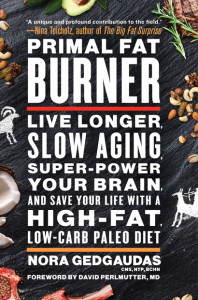
Interesting article Nora. Thanks.
http://thecarolinewalkertrust.org.uk/pdfs/2002%20lecture.pdf
Am interested to hear your thoughts on the link above.
These 2002 findings (which, to be fair, proceeded the stable isotopic data) are not consistent with reams of data that have emerged from the Max Planck Institute of Evolutionary Anthropology in Leipzig, Germany, where thousands of human remains from time periods throughout our earliest evolutionary history on forward display a very different picture of what we were eating. We became fully human 200,000 years ago, having arrived at a brain volume of just over 1500 cm³— well before 120,000 to 80,000 years ago, as suggested by this researcher as a time period where “recent fossil discoveries provide in convertible evidence of intense exploitation of the marine food chain”. His broader assertions are simply not supported by all of the available evidence for well-established hunting-based hominin economies based mainly on the pursuit of extremely large herbivores from no less than 2 million years ago. He seems to be a voice in the wilderness claiming that seafood was responsible for the evolution of our large brains, even though that was not— by all available evidence— a food that predominated the human food supply during any significant period of time our process of rapid encephalization was known to occur. They claimed that DHA was low in African savanna wild game, but supplied no data to support that contention. And bone marrow, in addition to brains are also a decent source of DHA, as well as the overall body fat of these extremely large prehistoric herbivores (for which he fails to account, and only seems to acknowledge the more current species of fauna on the African savanna). Even the very first hominid, Lucy (3.4-3.6 million years ago) was found to have created stone tools to cleave both meet and marrow from the bones of animals it scavenged. When I was on Ellesmere Island in the Canadian High Arctic, I was able to examine firsthand a number of ancient Thule sites where large numbers of discarded thick skulls of musk oxen had been cracked open for their brain content. There is no question that primitive hominins and humans would both have done this.
Finally, in my article I also cited the much more recent study showing the remarkable lack of fish consumption even in the Mediterranean region during the Mesolithic time period, where abundant seafood would’ve been readily available, and still people groups living there opted instead for a predominantly large herbivore-based diet.
I am not suggesting human beings never ate fish, or valued it as a food source. My contention is simply that based on all of the available evidence— and not simply outlier papers/ lecture transcripts such as this— the evidence is simply not there for the idea that eating fish is “mainly” responsible for growing our big brains. Not even close.
Warmly,
~Nora